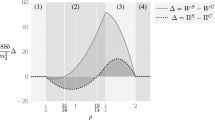Conclusions
The model developed here leads to some useful conclusions. If we consider an economy without trade where the supply of inputs varies in response to the level of current real consumption paid to inputs, then the relevant social input constraint for the planners is not a single production possibilities locus, but the planners feasibility constraint developed here. This constraint traces the locus of points on a family of production possibility surfaces that would be generated by each alternative quantity of inputs. The rate of product transformation along the planners' feasibility function will differ from the rate of product transformation along the production possibilities locus by an amount that reflects the marginal input supply.
In such an economy, whenever the arguments of the planners' welfare function are not identical with the arguments of the input supply function, the necessary conditions for the planners' optimum will be non-optimal with reference to usual market socialist welfare criteria. At equilibrium, the marginal rate of product substitution in the planners' welfare function will not equal the marginal rate of product transformation on the production possibilities function.
In addition, when the tastes of planners and of consumers diverge, the necessary conditions for the planners' optimum imply the exercise of some monopoly power by the planners. For given input supply conditions and given production functions, the magnitude of the monopoly effect increases to a limiting value as the diverge of tastes between planners and consumers increases.
Similar content being viewed by others
Sources
Robert M. Solow, “Capital, Labor, and Income in Manufacturing”, inThe Behavior of Income Shares (Princeton: National Bureau of Economic Research, 1964), pp. 101–41.
Benjamin Ward, “The Planners' Choice Variables”,Value and Plan, ed. Gregory Grossman (Berkeley: University of California Press, 1960), pp. 132–51.
Author information
Authors and Affiliations
Rights and permissions
About this article
Cite this article
Thornton, J., Leber, D.L. On the maximizing behavior of a monopoly planner. Econ Plann 10, 159–169 (1970). https://doi.org/10.1007/BF02342948
Issue Date:
DOI: https://doi.org/10.1007/BF02342948




